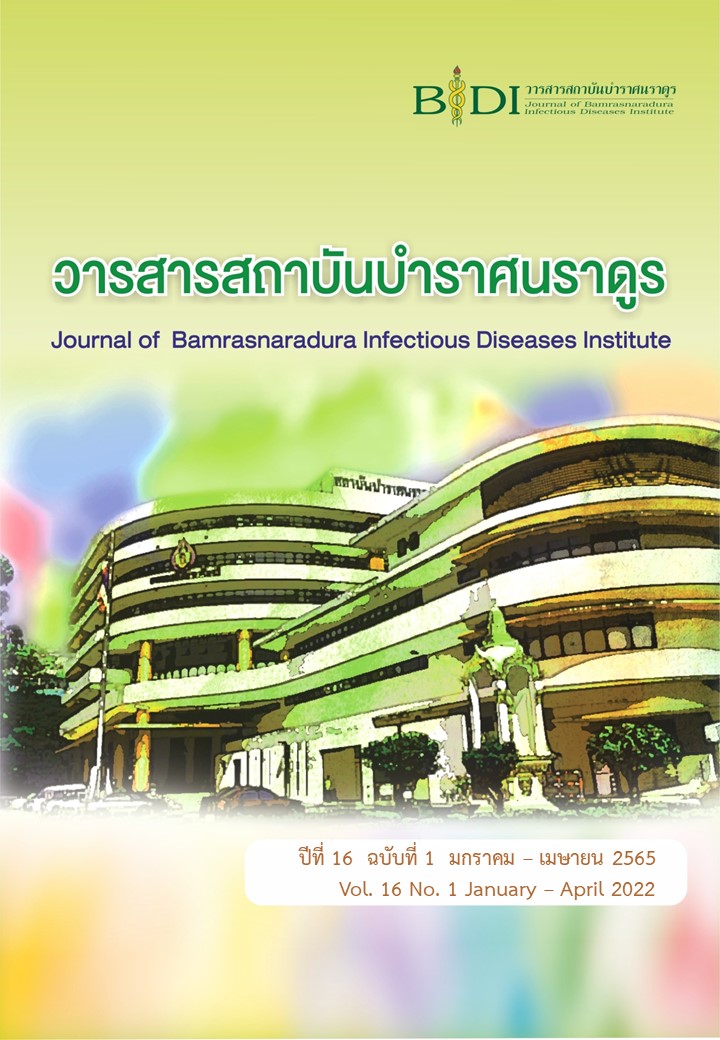ประสิทธิผลของการใช้มาตรการ VAP Bundle อย่างเข้มข้น เพื่อลดอัตราการเกิดVAP ในหอผู้ป่วยหนักระบบทางเดินหายใจ และหอผู้ป่วยหนักอายุรกรรม โรงพยาบาลอุตรดิตถ์
Main Article Content
บทคัดย่อ
วิจัยครั้งนี้มีวัตถุประสงค์เพื่อเปรียบเทียบอัตราการเกิด VAP ระหว่างกลุ่มผู้ป่วยที่ใช้ VAP Bundle แบบเดิม และใช้ VAP Bundle อย่างเข้มข้น การวิจัยแบบ Interrupted time design ศึกษาผู้ป่วยวิกฤตที่ใส่ท่อช่วยหายใจระหว่างเดือนตุลาคม 2559 ถึง เมษายน 2561 ทำการศึกษาผู้ป่วย 2 ช่วง คือกลุ่มแรกเป็นกลุ่มควบคุม ใช้ VAP Bundle แบบเดิม และกลุ่มหลังเป็นกลุ่มทดลอง ใช้ VAP Bundle อย่างเข้มข้น เก็บรวบรวมและวิเคราะห์ข้อมูล ร้อยละ ค่าเฉลี่ย ส่วนเบี่ยงเบนมาตรฐาน ทดสอบความแตกต่างของ proportion ด้วย exact probability test และทดสอบประสิทธิผลการใช้ VAP Bundle อย่างเข้มข้นด้วยสถิติ Cox’s regression model
ผลการวิจัย ผู้ป่วยที่ศึกษาทั้งหมด 164 ราย เป็นกลุ่มทดลอง 81 ราย คิดเป็นร้อยละ 49.4 และกลุ่มควบคุม 83 รายคิดเป็นร้อยละ 50.6 มี เพศ อายุ การวินิจฉัยโรค โรคร่วม GCS, APACHE II, Length of ICU, Length of Ventilator, การใช้ยาปฏิชีวนะ ยาสเตียรอยด์ ยาคลายกล้ามเนื้อ ยาแก้ปวดและยานอนหลับ ไม่แตกต่างกัน อย่างมีนัยสำคัญทางสถิติ ในกลุ่มทดลองที่ใช้แนวทาง VAP bundle อย่างเข้มข้นในทุกๆด้าน มากกว่ากลุ่มควบคุมอย่างมีนัยสำคัญทางสถิติ (p<0.001) มี Incidence rate ต่อ 1,000 วันใส่เครื่องช่วยหายใจน้อยกว่ากลุ่มควบคุม (3.00/1,000 ventilator-days และ 18.30/1,000 ventilator-days p= 0.001) และอุบัติการณ์การเกิด VAP ในกลุ่มทดลองลดลงอย่าง มีนัยสำคัญทางสถิติ (HR=0.13, 95%CI =0.03 – 0.49, p=0.003) การใช้ VAP Bundle อย่างเข้มข้น และมีการนิเทศ ติดตาม อย่างต่อเนื่อง จะทำให้อุบัติการณ์การเกิดปอดอักเสบจากการใช้เครื่องช่วยหายใจลดลง จึงควรนำไปใช้กับผู้ป่วยที่ใส่เครื่องช่วยหายใจทุกราย
Article Details
เอกสารอ้างอิง
Infectious Diseases Society of Thailand, The Thoracic Society of Thailand, Czech
Association of Critical Therapeutics Society and infection control in hospitals of Thailand.
Guidelines for the care and prevention of pneumonia in hospitals and ventilated pneumonia
In adults in Thailand. Bulletin of the Thai Association for Critical Care Medicine 2007; 15:1-10.
Hellyer P T, Ewan V, Wilson P, John A. The Intensive Care Society recommended bundle of interventions for the prevention of ventilator-associated pneumonia. J Intensive Care Soc. [Internat]. Published online 2016. .[cited 2017 may 12] Aug; 17(3): 238–243. Available from: https://www.ncbi.nlm.nih.gov/pmc/articles/PMC5606527/
Infectious Disease Prevention and Control Committee in Uttaradit Hospital. Guidelines for the prevention of pneumonia infection from ventilator use. Revision 2. 2560.
Faculty of Medicine Siriraj Hospital, Mahidol University, Bamrasnaradura Infectious Diseases Institute, Department of Disease Control. Guidelines for the prevention of pneumonia from mechanical ventilation. 1st ed. Bangkok: National Buddhism Office; 2009.
Holly K, Paola F. and Marcos I. R. Prevention of ventilator-associated pneumonia in the intensive care unit: A review of the clinically relevant recent advancements. Indian Journal of Medical Research 2014; 139: 814-21.
Eom JS, Lee MS, Chun HK, Choi HJ, Jung SY, KIM YS, et al. The impact of a ventilator bundle on preventing ventilator-associated pneumonia: A multicenter study. Am J Infect Control 2013; 42: 34-7.
Gupta A,Singh TK, and Saxsena A. Role of oral care to prevent VAP in mechanical ventilated Intensive Care Unit patients. Saudi J Anaesth [Internat]. 2016 [cited 2017 may 8]: 95-7. Available from: https://www.ncbi.nlm.nih.gov/pmc/articles/PMC4760051/
Siriphuvanun V, Churnjongkolkul W, Bochum V, Thanapornpoonpong S. Development of guidelines for endotracheal cuff inflation practice in patient with general anesthesia. Thai Journal of Nursing Council 2012; 27: 124-33.
Lim. K.P.,Kuo,S.W., Ko., W.J., Sheng., W.H., Chang, Y.Y., Hong, M.C. Efficacy of ventilator associated pneumonia care bundle for prevention of ventilator associated pneumonia in the surgical intensive care units of a medical center. Journal of Microbiology Immunology and Infection. 2013; 122:1–6.
Fields LB. Oral care intervention to reduce incidence of ventilator- associated pneumonia in the neurologic intensive care unit. J Neurosci Nurs. 2008; 40: 291-98.
Kalanuria, A. A, Zai. W and Mirski. M. Ventilator-associated pneumonia in the ICU. Critical care. [Internat]. 2014 [cited 2017 june 15]; 18: 208. Available from: https://pubmed.ncbi.nlm.nih.gov/25029020/
Gunasekera. P and Gratrix. A. Ventilator-associated pneumonia. BJA Education. [Internat]. 2016 [cited 2017 may 8]; 16: 198-202. Available from: https://academic.oup.com/bjaed/article/16/6/198/2364844
Roongruanghiranya S. How to Prevent Ventilator-Associated Pneumonia 2009. In Akarin
Bhumipichet, and Chairat Permpikul (Editors). Critical Care The Model of Holistic Approach
-2009. Bangkok: Beyond Enterprise. 2009. p. 250-63.
Piya Vejvirat k. Ventilator Associated Pneumonia. In Chanthapapa Srisawad, Pradej Rueangkanjanaset, and Vichai. Prayoonwiwat (editor). Common Problems in Internal Medicine. Bangkok: Medical College Tariff Project Phramongkutklao. 2010. p. 622-29.
Naopiriyawat U. Association Between Endotracheal Tube Cuff Pressure and the lncidence of Ventitator-Associated Pneumonia. 2013; 28: 7-8.
Sriyanalak N. Nursing Administration. 5th ed. Nonthaburi: Academic welfare project Praboromarajchanok Institute, Ministry of Public Health; 2014.


